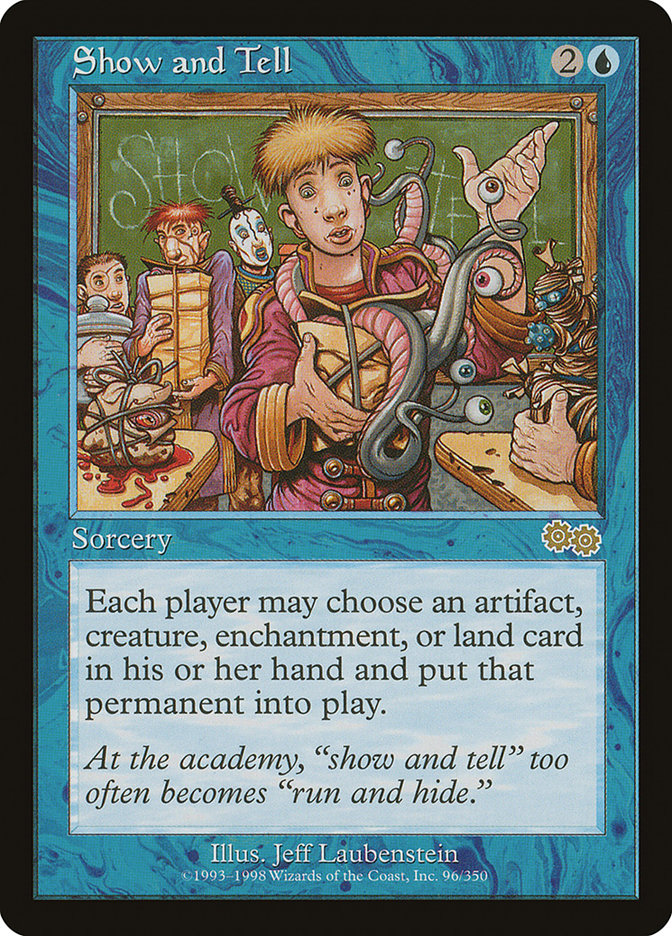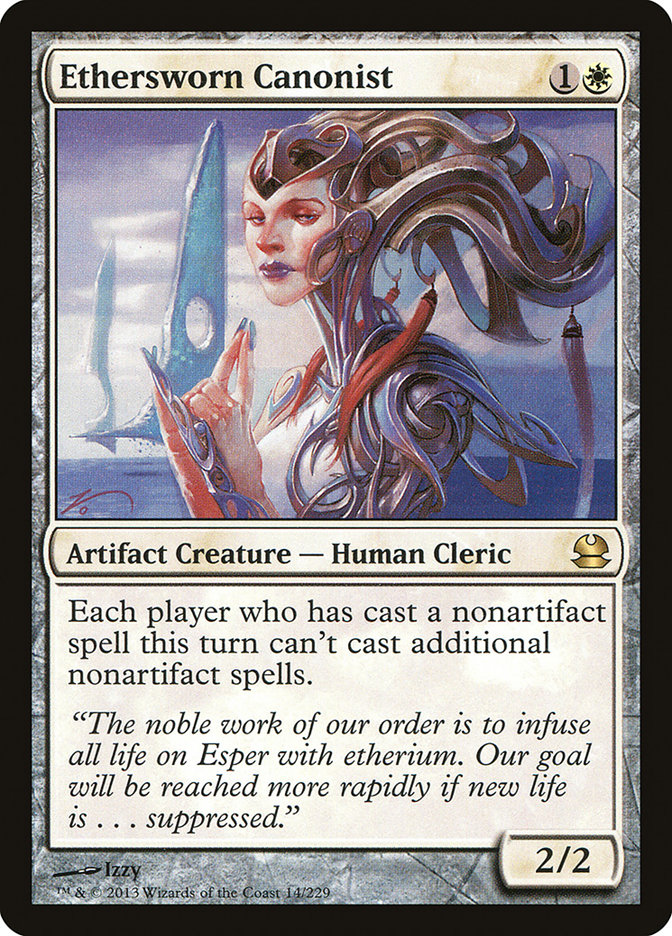After a little lull, Show and Tell, Legacy’s best traditional style combo engine (one where you try to assemble a couple of specific cards at the same time to win), has been putting up excellent results again lately between a win and a ton of Top 16 appearances in the last two SCG Opens.
Nearly two months ago, I wrote a piece comparing Legacy’s foremost Storm decks, The Epic Storm and Ad Nauseam Tendrils (which should really be called Past in Flames Tendrils). A lot of you seemed to really enjoy that one, and doing the same thing again for other archetypes was a request I got a lot. Today I’ll listen and do exactly that with Sneak and Show and Omni-Tell.
Once again, the goal here is to understand how these decks differ in approach to the game, speed, and other important factors such as consistency and interactiveness and where they resemble each other. Same as last time, I’ll start of by comparing the two decks side by side before delving into their significant differences, especially as capabilities and play styles with and against them are concerned.
Alright, let’s start science class!
What We Bring To Class
Over the years, we’ve seen a number of different decks built around the blue super Seething Song—that’s what Show and Tell is essentially: a blue ritual for 2U that produces anywhere from four to fifteen mana depending on if you’re putting in a Sneak Attack; an Emrakul, the Aeons Torn; or something in between.
Originally, there was a wide variety of different yet fundamentally similar Show and Tell decks: Hive Mind, Dream Halls, Sneak and Show, Burning Wish based Omni-Tell decks, and Hypergenesis, at the very least. With the printing of both Omniscience and Enter the Infinite, the Show and Tell archetype has largely condensed into exactly two versions: traditional Sneak and Show and the mono-blue Omni-Tell deck. Take a look at these two recently successful sample decklists:
Creatures (8)
Lands (19)
Spells (33)

Creatures (1)
Lands (10)
Spells (49)

I’m using Christopher Hein’s Omni-Tell list here instead of Brian Hood’s Open-winning version for one simple reason—it gives me the opportunity to explain the sweet Firemind’s Foresight "kill" some Omni-Tell players have access to. That is the kind of tricky deckbuilding choice I really love about Legacy and is not totally obvious from looking at the decklist. But enough talking, let’s take a look at the functional subgroups:
Colored Mana Sources
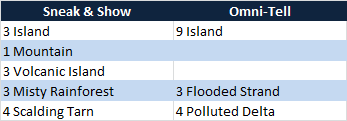
Mana Acceleration

Disruption

Library Manipulation
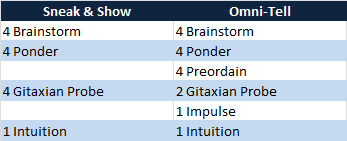
Combo Pieces
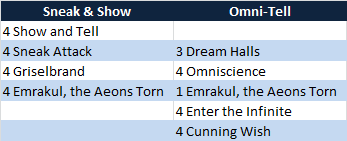
Similar to when I compared ANT to TES, there are a lot of similarities in how the functional subgroups break down between these two sibling decks. This shouldn’t be too surprising given that they’re both trying to cheat the mana cost of big spells, though there’s one big difference we can already observe simply due to where a particular card is listed. In Sneak and Show, Show and Tell functions as a full combo piece. Once the card resolves, your creature is in play, and you’ve successfully "comboed off." In Omni-Show, on the other hand, Show and Tell is really just a means to an end; the actual kill happens when other cards combine with what was Showed into play, relegating it fully to the role of a Seething Song that makes 7UUU.
As a result, Sneak and Show runs significantly more actual mana acceleration than Omni-Tell and spends a couple more slots on mana in general. This indicates that Sneak and Show looks to blow by opponents through overwhelming speed much more than the mono-blue list.
This impression is reinforced by the fact that these slots serve to raise Omni-Tell’s library manipulation count to a ridiculous full twelve cantrips plus Gitaxian Probes and other tools, another indication that it aims to play a somewhat more drawn-out game.
A look at both decks’ colored mana sources only strengthens this conclusion. While Sneak and Show needs to support two colors and thereby opens itself up to Wasteland and uses only fourteen colored sources, the Omni-Tell deck has a whopping three lands that can be killed by Legacy’s most common way to keep mana bases honest, with sixteen basic Islands and fetch lands providing most of the resources necessary. The vulnerable lands are all City of Traitors, a card you’re unlikely to need before you’re ready to win anyway. This kind of resilience is a huge edge in games that take more than a turn or two.
The biggest differences between the two decks become apparent in the combo piece section though. Now, I’m not talking about the fact that one deck has creatures and the other has enchantments—that part should be obvious if you can read—but how these pieces interact to actually deliver the kill.
The Sneak and Show deck uses its enablers to simply put a ridiculous creature into play and hopes to win by attacking with it. The Omni-Tell deck, on the other hand, not only needs to get one of its enchantments down but also has to use that to cast Enter the Infinite, which then leads directly into an on-turn combo kill.*
*For those of you not in the know, the basic win works like this: cast Enter the Infinite, put a ridiculously expensive card back, Cunning Wish for Release the Ants, and cast it as often as necessary to kill your opponent. Most decks can’t win a clash against a twelve-drop, after all. Against decks with Gaddock Teeg (or its own twelve-plus drops), you can also use Cunning Wish to retrieve Eladamri’s Call and hard cast an Emrakul, Time Walk, and all with Omniscience.
These different plans come with some advantages and some disadvantages. Going for a single-turn kill based on making your spells free and drawing your deck avoids a significant amount of interaction that Sneak and Show has to worry about, from Humility and Ensnaring Bridge to Karakas, and also often negates the opponent’s permanent from Show and Tell because they’ll never have time to use it when they’re dead. The kill is also strictly safer. I’ve seen a lot of people survive Emrakul hits and come back to win the game—in fact, I’ve done that more than once myself with Storm.
There is also a steep cost to pay for having the more powerful kill—Omni-Tell ends up being a two-and-a-half-card combo deck instead of a straight two=card combo. If you’re hard casting Dream Halls—quite expensive at five mana but nearly identical to Sneak Attack’s 3R plus R—everything is fine. You now just need an Enter the Infinite and a random blue card to end the game. The problem comes from the second free spell enabler, Omniscience.
 |
vs. |
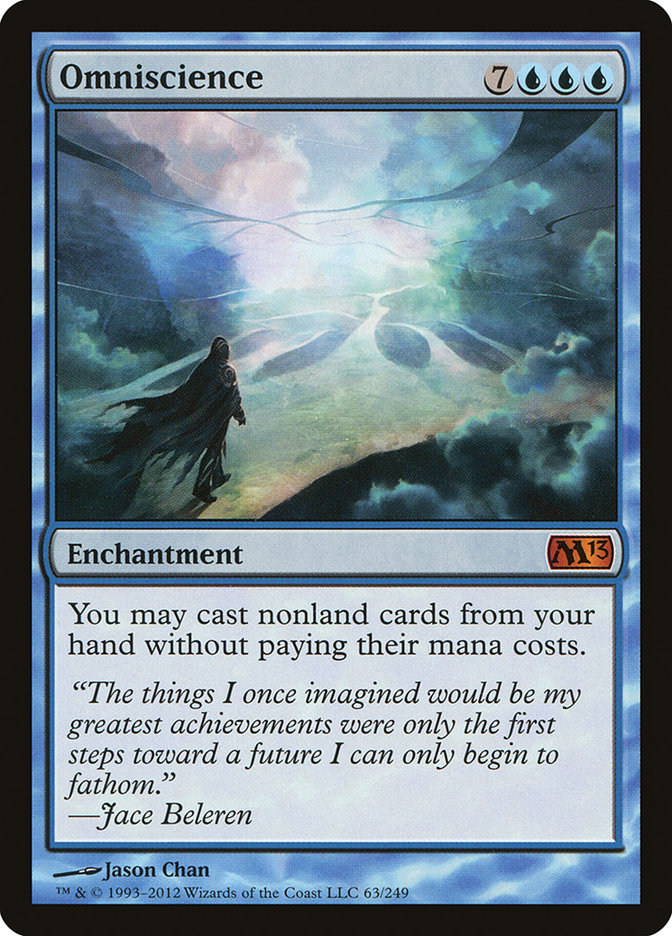 |
While it is significantly better once in play, there’s a snowflake’s chance in hell you’ll ever end up hard casting it. The only ways to get it out are Dream Halls—which can already cast Enter on its own—and Show and Tell, meaning for an actual kill using Omniscience you need three specific cards.
In this Omni-Tell is reminiscent of earlier alternative Show and Tell decks; take Hive Mind, which had both an easy two-card combo—Emrakul plus Show and Tell—and a three-card Show and Tell accelerated instant win with Show and Tell plus Hive Mind plus Pact of something or other. Omni-Tell blows these older versions of the mixed combo deck out of the water because both its combos deliver the instant kill, but the consistency issues related to assembling a three-card combo remain.
Omni-Tell compensates for this disadvantage by running a full eight ways to win once the mana-cheating engine is online. Enter the Infinite is the obvious kill, but Cunning Wish works as an excellent stand-in once your spells don’t cost mana anymore. By Cunning Wishing for Firemind’s Foresight (or simply an Intuition in a lot of lists), you have an additional four ways to find your Enter the Infinite and win.* Essentially, you’re a two-card combo deck that runs three plus nine (Intuition in hand works perfectly fine too) combo pieces, as well as a three-card combo deck that runs four and four and nine pieces. It seems that’s enough to make it consistent in spite of the natural disadvantage of three-card combos.
*The Intuition kill should be obvious: Wish for Intuition, Intuition for three Enter the Infinite, and cast the one they give you. Firemind’s Foresight makes things a little trickier but has a huge advantage when your enabler is Dream Halls. What you do is Wish for Firemind’s Foresight, and cast that to find a cantrip, the Impulse, and the Intuition (which then finds Enter as above). Why is that good? Well, when your enabler is Omniscience, the whole thing is pointless. When using Dream Halls, however, Foresight provides a huge upgrade since you can win with fewer cards left in hand.
Check it out: Wish for Intuition (one card pitched), Intuition (two cards pitched), Enter the Infinite (three cards pitched) compared to Wish (one card pitched), Firemind’s Foresight (effectively zero cards pitched since Foresight replenishes your hand), Intuition (one card pitched), Enter the Infinite (two cards pitched). This makes winning with Dream Halls significantly easier, especially in the face of hand disruption and countermagic that will put a strain on your hand size.
Finally, looking at the disruption suite reveals another huge advantage of having access to a single turn-kill—Omni-Tell gets to use Pact of Negation to protect its combo attempt since it will never see another upkeep once it has gone off, whereas Sneak and Show has to make do with Misdirection and countermagic that costs mana. Having a truly free counter to punch your cards through is an incredible edge against blue-based decks, and the fact that none of your protection spells ever lose value (like Spell Pierce does after turn 2-3 in Sneak and Show) makes you significantly stronger when fighting an interactive opponent.
Strategic Implications
The picture emerging from the above observations resembles what we saw when looking at TES and ANT. Of the two combo decks we’re looking at, one is set up to get its combo to fire as early as possible, while the other is better prepared to win a game that enters the grinding phase.
Sneak and Show needs fewer and cheaper pieces to go off and has more acceleration. In addition, its kill loses potency quite rapidly as the game progresses (a lot of decks can handle or invalidate Emrakul and even Griselbrand by turn 4 or 5, especially when it’s Show and Telled in instead of Sneaked) and sometimes even can’t win for multiple turns after going off (usually when going off means Sneak Attack powering out Emrakul). Reliance on Griselbrand also makes the deck somewhat susceptible to fast damage if it stumbles or is stopped once.
Omni-Tell, on the other hand is incapable of winning before turn 2 and needs very specific cards to do so, making it more of a turn 3-4 deck. By slowing down this much, though, it gains incredible library manipulation, a pretty much impossible-to-attack mana base, and a kill that will win however far the opponent’s board has advanced or your life total has dwindled down.
Essentially, while both rely on Show and Tell to power out huge cards, the two decks have two completely different philosophies. Sneak and Show tries to overwhelm the opponent by casting overpowered threats as soon as possible, using cheap countermagic to punch through and sometimes protect its combo pieces. To do that it makes itself vulnerable to Wasteland and blows cards on acceleration in Lotus Petal.
The mono-blue Omni-Tell deck, on the other hand, gains its power not from speed—it’s actually quite slow for a Legacy combo deck—but from being incredibly hard to interact with. I mean, think about what a typical game for the deck will look like. You play basic Islands, maybe a single fetch land (which you should be able to crack when it can’t be Stifled if you’re taking care), and one-mana cantrips for two-to-four turns, following that up by resolving an enabler and ending the game.
The only reasonable ways to interact with Omni-Tell are discard (which is why you sideboard Leyline of Sanctity to make interaction even less possible) and countermagic—there simply isn’t anything else to touch!
Mana denial is hamstrung by deck construction alone, and because that’s the case, soft counters—Daze in particular—lose a lot of their value against Omni-Tell. The deck doesn’t use the graveyard, it has ways to win through most available hate bears—largely thanks to the flexibility of Cunning Wish to either find a solution or go for the Emrakul kill—and once it has punched the win through countermagic with its own seven free hard counters, it ends things before the opponent gets another turn to find a solution. I think a case could be made that Manaless Dredge allows for more interaction than this deck does!
So in short, while using similar setups and abusing the same powerful spell in Show and Tell, as with the Storm decks, we once again see a very different focus from each of our exhibits. That shouldn’t be too surprising—after all, if one were strictly better than the other, it should have replaced its competitor in the metagame. Instead, we see two similarly powerful decks coexisting and preying on different situations, opponents, and metagames.
Face Off
So what do these differences mean when you sit down in front of a Show and Tell opponent? Well, first and foremost, you need to be more careful against Sneak and Show. The earliest Omni-Tell can win is on turn 2, and it needs to draw exactly one of three City of Traitors, a Show and Tell, a mana-cheating enchantment, and a way to get Enter the Infinite. Even with a lot of pieces available in abundant numbers, because Show and Tell and City of Traitors are in such low supply, turn 3 and later is when you really have to start worrying.
Against Sneak and Show, on the other hand, a four-of (Lotus Petal), a five-of (the sol lands), a Show and Tell, and a fatty delivers not a turn 2 win but a straight first-turn Emrakul or Griselbrand. Similarly, there are a multitude of combinations that will allow you to resolve your enabler on turn 2.
Due to this speed difference, early countermagic and discard are of major importance against Sneak and Show, while something relatively slow such as Counterspell is an excellent tool against Omni-Tell even though you often won’t have time to cast it against Sneak and Show. In addition, you can tap out much more aggressively against Omni-Tell early in the game. as the odds of them punishing you are quite low.
On the other hand, you should be much more scared of entering a long game against the mono-blue deck. With Pact of Negation in addition to Force of Will, the deck has enough hard countermagic to back up its threats, and the full cantrip cartel plus a couple of Gitaxian Probes makes sure the deck is going to out-quality most opponents significantly. While Sneak and Show can often win on turn 2 or 3 with Force of Will backup, you shouldn’t be surprised to find the Omni-Tell deck protecting its win with two or even three free counterspells, though that likely means the win won’t happen before turn 5 or 6.
You also need to look at different cards to use against these decks. There are many more cards that will help defeat Sneak and Show, most of them being different ways to hose (legendary) creatures. None of these is of the slightest use against Omni-Tell. The one answer card that helps against both decks is Oblivion Ring (and its clone, Detention Sphere) because it will eat an Emrakul just as happily as an Omniscience if brought in with Show and Tell. Omni-Tell is even equipped to deal with that eventuality, though, as an in-hand Cunning Wish will be able to get Trickbind to keep Omniscience around (all paid for by said Omniscience—you still have it in play when the Oblivion Ring trigger goes on the stack). Sure, you’ll need another way to get to Enter the Infinite, but at the very least, your spells are still free.
Ethersworn Canonist and cards like Thalia, Guardian of Thraben and Trinisphere, on the other hand, are much better against Omni-Tell than against Sneak and Show. Against the latter, you might buy a turn by making Show and Tell cost four, but overall its ability to win is only slightly impacted, while Canonist only becomes relevant at all when the opponent can counter in addition to having the hate bear since Canonist prevents them from countering back. Other than that, though, well, you weren’t planning on playing more than one spell per turn anyway, were you?
Against Omni-Tell, on the other hand, Canonist makes it incredibly hard for them to win—they have to get their enabler down, pass the turn, Cunning Wish for Wipe Away, and cast it before finally being able to win on their turn. If they don’t have the Wish, things become even more awkward because casting Enter the Infinite leaves them with only one card in their library. They are now absolutely all in on Wish during your turn and bounce during theirs, though they can buy a couple of turns of not decking by casting more Enter the Infinites. Note also that they can’t protect their Wish since Canonist still makes counter wars impossible.
Trinisphere will likely have pretty much the same effect on them—they still need to pay Trinisphere mana even with Omniscience out, so they’re down to one or maybe two spells a turn. Thalia and Thorn of Amethyst are less effective but usually also push back the win by at least a turn. Show and Tell will cost four (and Dream Halls six!), and afterward they still need at least two mana to Cunning Wish for Eladamri’s Call, get Emrakul with that, and hard cast it through Omniscience.
Class Dismissed
There you go, a close look at the differences between the two main representatives of Legacy’s other combo pillar—the one that isn’t storm. I hope this helped clarify what these decks are aiming to do, where their strengths and weaknesses lie, and why there are two different Show and Tell based decks. If you’d like an easy-to-remember rule of thumb, Sneak and Show could be considered the Show and Tell equivalent of TES—fast and deadly but becomes weaker as the game progresses—while Omni-Tell is basically the Show and Tell version of ANT—the grindy combo deck that wants to win once it has exhausted its ability to further ameliorate its hand.
And with this profound observation, I’m going to leave you for today. I hope you enjoyed this in-depth look at the decks with the highest curve in all of Magic—at least as far as I know. If there’s anything I got wrong, wasn’t clear on, or you just think I should know, go ahead and post it in the comments. I’ll be looking!
Until next time, teach your opponents a lesson!

